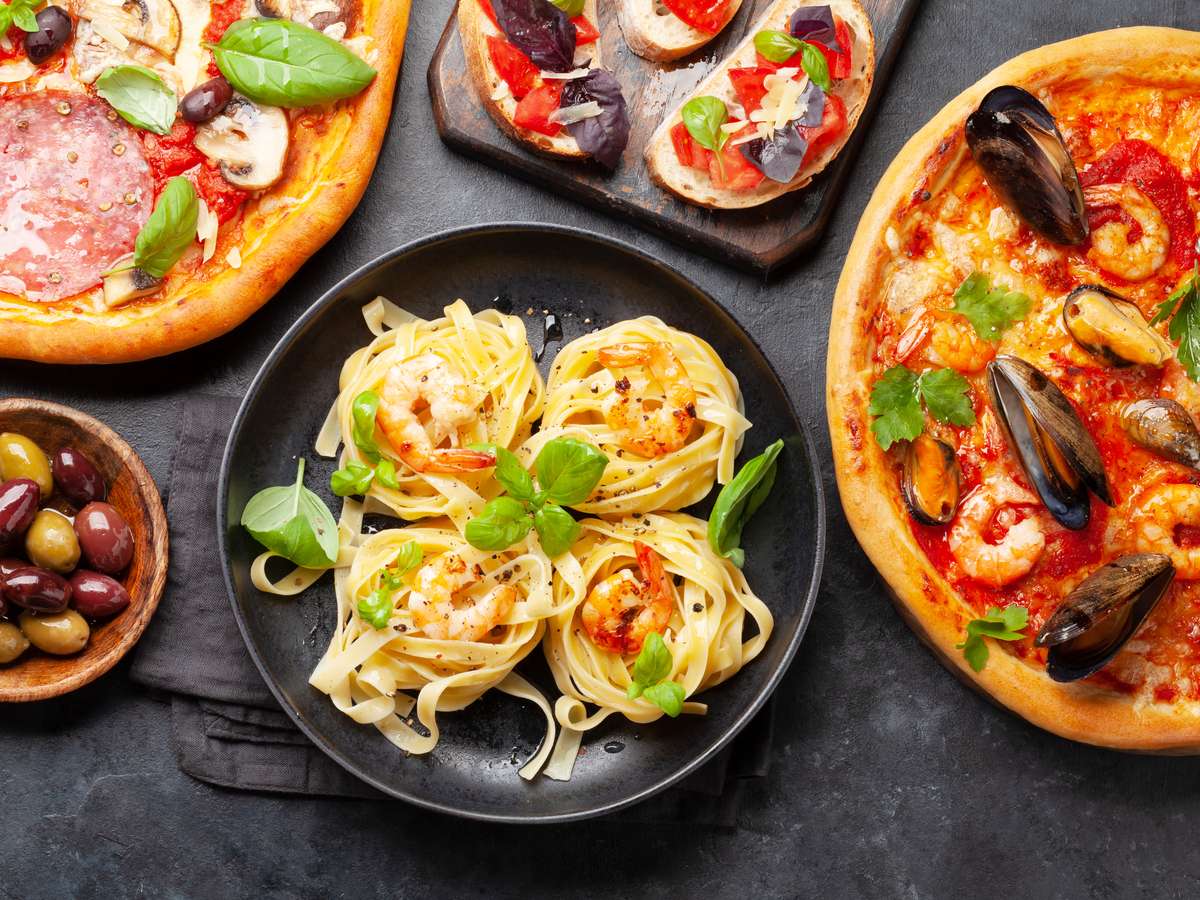Is Pizza a Pasta? [With Differences and Similarities!]

Pizza and Pasta both have Italian origins, and are two of Italy’s most popular exports. Often times than not they are paired together at parties and gatherings. One might be tempted to believe they are the same. Although they do have a few similarities they are not the same.
A pizza is not pasta. The biggest difference is in the kind of dough used to make the dishes. Pizza is made with leavened dough and pasta with unleavened dough. However, there are a few similarities such as the addition of vegetables, meats, Italian herbs, sauce, and cheese that are common for both.
In this article, we shall understand the differences between pizza and pasta as well as look into some of the commonalities between the two that create perplexity.
Differences between Pizza and Pasta
1. Dough
The primary difference between pizza and pasta is the dough they make. Pizza is made with the leavened(fermented) dough which uses yeast or other raising agents to aerate the dough. Whereas, pasta is made with unleavened dough which is then shaped in different shapes and dried.
Suggested Reading: Is Pizza And Pasta Flour The Same? [Here’s The Difference!]
2. Shape
Pizza is round in shape mainly because the aerated dough is slowly stretched using the hands in a circular motion so that the dough retains the trapped air bubbles. After the dough reaches a certain circumference it is then tossed in the air with the hands.

The force of throwing the dough in the air in a circular motion causes the pizza to be round in shape. However, other shaped pies such as triangles, squares, and rectangles are also available. Whole pizzas or slices of pizza shaped in triangles are widely popular in New York. Rectangular-shaped pizza especially around Detroit and New Jersey.
Suggested Reading: Is There Yeast In Pasta?
Pasta on the other hand has to be shaped using the hands into various shapes and dried as the pasta dough is very dense and not stretchy. This works for pasta as during the cooking process it helps the pasta to absorb the water as well as retain its shape.
3. Sauce
Pizza and pasta both use tomato sauce. However, one of the major differences is that the pizza sauce makes use of uncooked tomatoes, whereas pasta sauce is made from cooked tomatoes seasoned with herbs.
Related Reading: Can I Use Pasta Sauce For Pizza?[All You Need To Know!]
Another major difference is that tomato-based sauce is put on the pizza bread and then spread evenly using a spatula or a spoon. Whereas Pasta is added to the sauce and tossed in it so that pasta is coated well with the sauce and absorbs the flavors.
4. Method of cooking and temperatures
The method of cooking both Pizza and pasta differs vastly. Pizza dough is rolled over and assembled with sauce, and toppings such as meats, vegetables, cheese, and seasonings. This dough is then cooked in an electric oven or a brick oven on high heat. Higher temperatures of 250-300 degrees are the best to cook a pizza.
Pasta dough that has been cut and shaped has to cook in boiling water so as to absorb the moisture from the boiling water and cook from within. The temperature while cooking pasta does not reach as high temperatures when cooking a pizza.
Similarities between Pizza and Pasta
1. Sauce
The sauce that is used for the pizza and pasta is tomato based. The other commonly used sauce is cheese sauce or alfredo sauce. Although tomato sauce which is used for pizza differs from what is used for pasta. However, the cheese sauce is the same. It starts with making a roux base for the sauce and then adding the dairy and cheese.
Related Reading: Can You Use Pizza Sauce For Pasta?[Easy Way To Do It!]
2. Vegetables & Meat
Vegetables such as bell peppers, onions, garlic, zucchini, cherry tomatoes, corn, mushrooms, olives, etc. are common for both pizza and pasta. Protein sources such as various cuts of meat, bacon, meatballs, chicken, turkey, and seafood are commonly added to pizza and pasta as well.
Related Reading: Does Pasta Contain Egg? [A Complete Guide!]
3. Herbs & Seasonings
Italian seasonings and dried herbs such as oregano, chili flakes, paprika, garlic powder, onion powder, thyme, rosemary, and basil are great to add flavor to both pizza and pasta. Fresh herbs such as basil, kale, arugula, and chopped parsley are popular in adding freshness to both dishes.
4. Cheese
Another commonality between pizza and pasta is cheese. A pizza without cheese is incomplete. A portion of pasta without cheese doesn’t make it the most comforting. Thus, we have variations of tomato-based pasta sauces commonly also referred to as pink sauce.
In fact, some of the most popular pasta dishes are made with cheese and dairy without the addition of tomatoes such as Macaroni and cheese, chicken alfredo pasta, creamy garlic chicken pasta, etc.
More Related Articles:
Here are a few more articles that might interest you!
![Difference Between Pasta and Macaroni [Here’s What to Know!]](https://myhousehacks.com/wp-content/uploads/2022/08/Macaroni-768x512.webp)
![How to Make Kraft Mac and Cheese? [Healthy, Tasty, Creamy!]](https://myhousehacks.com/wp-content/uploads/2023/01/ezgif.com-gif-maker-31-768x576.jpg)
![Difference Between A Blender And A Smoothie Maker [What you should know!]](https://myhousehacks.com/wp-content/uploads/2022/11/ezgif.com-gif-maker-31-768x576.jpg)
![What is Cooking Cream for Pasta? [Full List With Examples!]](https://myhousehacks.com/wp-content/uploads/2022/07/eugene-kuznetsov-Za6O7mW5_iU-unsplash-768x516.jpg)
![How to Cut a Pizza Into 9 Slices! [Simple and Best Ways!]](https://myhousehacks.com/wp-content/uploads/2023/02/ezgif.com-gif-maker-81-768x576.jpg)
![Why is My Mac and Cheese Dry? [And Here’s How to Fix It!]](https://myhousehacks.com/wp-content/uploads/2022/08/mac-and-cheese-3-768x576.webp)